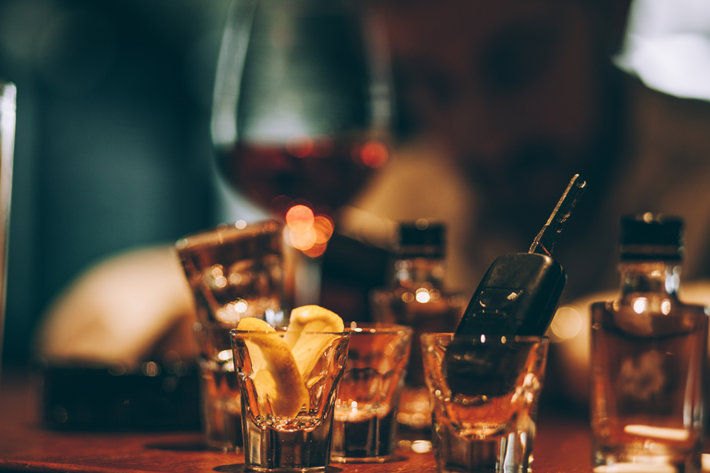Binge Drinking Defined

While it is true that any degree of alcohol consumption presents a health risk, there is a level of drinking that society generally considers is “too much” drinking.
That’s kind of an odd concept though, that a certain amount of drinking is considered “too much” if the reality is that any amount of drinking presents risk.
Why the term “binge drinking” if any amount of drinking presents risk? Why are there different “levels” of drinking, like allegedly “moderate” drinking, binge drinking, and heavy drinking? Any degree of alcohol consumption presents harm, with that harm being greatly exacerbated the more one drinks.
What is Binge Drinking?
The National Institute on Alcohol Abuse and Alcoholism lays out a direct, concise explanation for binge drinking:
Binge drinking is defined as “a drinking pattern that brings blood alcohol concentration levels to 0.08 g/dL”. To put that measurement into perspective, a blood alcohol content of 0.08 g/dL usually occurs at four drinks for women and five drinks for men in about two hours.
According to the same article, the Substance Abuse and Mental Health Services Administration defines binge drinking as an incident of drinking that involves 5 or more alcoholic drinks for men or 4 or more alcoholic beverages for women within one period.
Between the data from the NIAAA and from SAMHSA, it’s clear that binge drinking is both a level of alcohol consumption and a specific behavior of intermittently consuming vast quantities of alcohol in a relatively short period of time, followed by a period of abstinence.
But the truth is, any degree of drinking opens the door to health risks. As soon as one starts consuming alcohol, even just one drink, the alcohol begins to have an effect on reaction time and cognitive function.
According to a 2018 survey, approximately 26 percent of Americans ages 18 and older engaged in at least one binge-drinking incident in the month leading up to the study.
Binge drinking is surprisingly common. According to a 2018 survey, approximately 26 percent of Americans ages 18 and older engaged in at least one binge-drinking incident in the month leading up to the study. About six percent of survey respondents admitted to binge drinking several times in the month leading up to the survey.
The prevalence of underage binge drinking is also shockingly high. About 4 million young people between the ages of 12 and 20 admitted to binge drinking in the month leading up to the survey. That’s about 11 percent of this age group’s total population! About 2 percent of this 12-20-year-old age group (861,000 young people) admitted to binge drinking several times in the month leading up to the survey.
Once young people get into college, binge drinking rates skyrocket. For college students, ages 18 to 22, about 37 percent admitted to binge drinking in the past month. That figure can also be compared to the same age group that is not in college. For 18 to 22 year-olds not in college, 27 percent admitted to binge drinking in the past month.
The consequences of binge drinking are extreme, even lethal. About 1,825 college students between the ages of 18 and 22 die from alcohol-related incidents every year. Another 696,000 suffer a violent, alcohol-related assault, and 97,000 experience an alcohol-related sexual assault.
There’s also particular harm when young people binge drink. For adolescents and young adults, binge drinking interferes with brain development. Underage drinking also vastly increases the risk of developing an alcohol addiction later on in life.
Binge drinking has severe consequences in other areas of life too. About one in ten children grow up with at least one alcohol-addicted parent, and about 10,000 people die every year from drunk driving accidents.
Speaking of drunk driving deaths, the sheer death toll from drinking too much alcohol is, without a doubt, the most horrible of all the effects that binge drinking can have. Every year in the United States, about 88,000 people die from alcohol-related causes, more than the combined total of all drug-related deaths. And globally, alcohol is responsible for about five percent of all annual deaths worldwide.
Binge Drinking and Heavy Drinking
Binge drinking refers to a level of alcohol consumption on any given day that brings BAC to .08 or above. According to SAMHSA, heavy drinking is defined as engaging in binge drinking on five or more occasions in the past month. Heavy drinking is also defined by the NIAAA as consuming more than four drinks in a day for a man, three in a day for a woman. Both binge drinking and heavy drinking drastically increase one’s risk for adopting alcohol addiction, and both drinking patterns qualify as alcohol misuse.
Seeking Help for Alcohol Abuse
Any amount of alcohol consumption presents risk. Anyone who is in recovery from alcohol addiction should not drink at all, ever. And for those who are still actively misusing alcohol, they must seek help at a drug and alcohol rehab center as soon as possible.
When people think of addiction, they usually think of substance abuse on the part of someone who cannot stop themselves from using drugs every day. And for many addicts, that’s precisely what addiction looks like.
But not for all addicts.
Some people who struggle with addiction manage to consume mind-altering substances on an intermittent basis. This is especially common among people who are addicted to alcohol. Such individuals may go several days without drinking and then consume massive quantities of alcohol over a short period.
It is erroneous to assume that addicts must use alcohol daily for them to be addicted to the substance. Not so. Addiction is defined simply as: “a need to use a harmful substance and not being able to stop using it”. For example, many alcohol addicts will function normally during the week and then get extremely drunk on the weekends. Such individuals need help because their use pattern is highly dangerous and always gets worse unless they get help.
This is why we often underestimate how many people are addicted to alcohol in this country. We tend to not view people who binge drink on the weekends as having alcohol misuse problems, but they absolutely do.
If you know someone who cannot control their drinking, who drinks to excess, who harms themselves or others with their alcohol consumption, even if they do not drink every day, please do your best to get them help. Alcohol addiction does not go away on its own, and it always gets worse if it is not treated. Please do what’s best for your loved one and help them get into a residential drug and alcohol addiction treatment center.
Sources:
- https://www.niaaa.nih.gov/publications/brochures-and-fact-sheets/alcohol-facts-and-statistics
- https://www.niaaa.nih.gov/alcohol-health/overview-alcohol-consumption/moderate-binge-drinking


